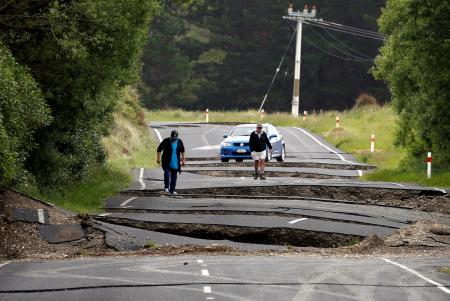
By Charlotte Greenfield and Greg Stutchbury
WELLINGTON (Reuters) – A strong new earthquake with a magnitude of 6.2 rattled New Zealand’s South Island on Monday, hours after a more powerful quake killed at least two people, damaged roads and buildings and sent thousands fleeing to higher ground.
Emergency response teams were flying by helicopter to the region at the epicentre of the original 7.8 magnitude quake, which struck just after midnight some 91 km (57 miles) northeast of Christchurch in the South Island, amid reports of injuries and collapsed buildings.
New Zealand’s capital Wellington was a virtual ghost town with workers ordered to stay away while the city council assessed the risk to buildings. Severe weather with 140 km per hour (85 mph), gale-force winds was forecast for the area.
The new tremor, a 6.2 quake recorded at about 1.45 p.m. local time (0045 GMT), was the most powerful of hundreds of aftershocks in the South Pacific country. It rattled frayed nerves in an area where memories of a deadly 2011 quake are still fresh.
Christchurch, the largest city on New Zealand’s ruggedly beautiful South Island, is still recovering from the 6.3 quake in 2011, which killed 185 people.
In the upper South Island, powerlines and telecommunications were down, with huge cracks in roads, land slips and other damage to infrastructure making it hard to reach the worst-affected areas.
“It’s just utter devastation, I just don’t know … that’s months of work,” New Zealand Prime Minister John Key told Civil Defence Minister Gerry Brownlee after flying over the area, according to Twitter statement issued by Brownlee.
New Zealand’s Civil Defence declared a state of emergency for the South Island’s Kaikoura region, centred on a tourist town about 150 km (90 miles) northeast of Christchurch, soon after Monday’s large aftershock.
Kaikoura, a popular spot for whale watching, appeared to have borne the brunt of the quake.
Urban Search and Rescue (USAR) said later on Monday a 20-person rescue team and two sniffer dogs had arrived in the town. A second team was on standby in Christchurch, USAR said in a statement.
TWIN QUAKES
Hours after the quake, officials said a slip dam caused by the quakes that had blocked the Clarence River on the South Island had breached, sending a wall of water downstream.
“Residents are urgently advised to move to higher ground immediately,” RNZ quoted a statement from the Marlborough District Council as saying.
A tsunami warning that led to mass evacuations after the original quake was downgraded after large swells hit Wellington, in the North Island, and Christchurch. There were no new tsunami warnings issued after the 6.2 aftershock.
New Zealand’s Geonet measured Monday’s first quake at magnitude 7.5, while the U.S. Geological Survey put it at 7.8. The quakes and aftershocks rattled buildings and woke residents across the country, hundreds of kilometres from the epicentre.
Government research unit GNS Science later said the overnight quake appeared to have been two simultaneous quakes which together lasted for more than two minutes.
New Zealand lies in the seismically active “Ring of Fire”, a 40,000 km arc of volcanoes and oceanic trenches that partly encircles the Pacific Ocean. Around 90 percent of the world’s earthquakes occur within this region.
Stock exchange operator NZX Ltd (NZX.NZ: Quote) said markets were trading, although many offices in the capital were closed. The New Zealand dollar NZD= initially fell to a one-month low before mostly recovering.
Fonterra (FCG.NZ: Quote), the world’s biggest dairy exporter, said some its farms were without power and would likely have to dump milk. There are about 30 farms in the Kaikoura area, it said in a statement. Most of its manufacturing sites were operating as usual, it said.
Key postponed a trip to Argentina, where he had planned to hold a series of trade meetings ahead of the Asia-Pacific Economic Cooperation (APEC) leaders’ summit in Peru this week, as he met disaster officials.
At least one of those killed was found in a house in Kaikoura that “collapsed like a stack of cards”, Kaikoura Hospital’s Dr Christopher Henry told Fairfax media. Two other people were pulled alive from the same building.
New Zealand media reported one of the pilots taking rescuers to the area was Richie McCaw, the recently retired captain of New Zealand’s world champion All Blacks rugby team.
“At one point, the railway was way out over the sea – it had been pushed out by (land) slips. It would not have been a nice place to be at midnight last night,” McCaw told the New Zealand Herald after helping fly the USAR team to Kaikoura.
Kevin Heays, of Environment Canterbury in Kaikoura, told Radio New Zealand roads were badly damaged and power poles were down, effectively isolating the town. New Zealand television reported that water to the town had also been cut off.
Residents in Wellington caused gridlock on the roads to Mount Victoria, a hill with a lookout over the low-lying coastal city. Around 100 people, including children sleeping on floors and benches, camped out overnight in the distinctive parliament “Beehive” building.
(Additional reporting by Greg Stutchbury in WELLINGTON, Jamie Freed, Wayne Cole and Jane Wardell in SYDNEY; Writing by Paul Tait; Editing by Lincoln Feast)
